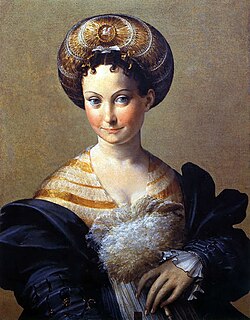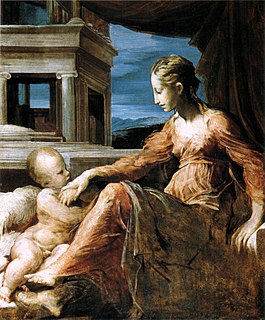
Museo di Capodimonte is an art museum located in the Palace of Capodimonte, a grand Bourbon palazzo in Naples, Italy. The museum is the prime repository of Neapolitan painting and decorative art, with several important works from other Italian schools of painting, and some important ancient Roman sculptures. It is one of the largest museums in Italy. The museum was inaugurated in 1957.

The Madonna with the Long Neck, also known as Madonna and Child with Angels and St. Jerome, is an Italian Mannerist oil painting by Parmigianino, dating from c. 1535-1540 and depicting Madonna and Child with angels. The painting was begun in 1534 for the funerary chapel of Francesco Tagliaferri in Parma, but remained incomplete on Parmigianino's death in 1540. Ferdinando de' Medici, Grand Prince of Tuscany, purchased it in 1698 and it has been on display at the Uffizi since 1948.

Cupid Making His Bow is a painting by the Italian late Renaissance artist Parmigianino. It is housed in the Kunsthistorisches Museum, Vienna, Austria.

Portrait of Galeazzo Sanvitale (1524) is a painting of the condottiero Gian Galeazzo Sanvitale by the Italian late Renaissance artist Parmigianino. It is housed in the National Museum of Capodimonte, Naples, Italy.

Portrait of a Collector is a painting by the Italian Mannerist artist Parmigianino, executed around 1524.

Turkish Slave is a painting by the Italian Mannerist artist Parmigianino, executed around 1533. It is housed in the Galleria nazionale di Parma, northern Italy.

Portrait of Pier Maria Rossi di San Secondo is a painting by the Italian Mannerist artist Parmigianino, executed around 1535–1539 and housed in the Museo del Prado, Madrid, Spain. The subject was Count of San Secondo, and the painting forms a pair with a group portrait of his Countess and their children, Portrait of Camilla Gonzaga and Her Three Sons, although the latter is not unanimously attributed to Parmigianino.

Portrait of Camilla Gonzaga and Her Three Sons is a painting attributed to the Italian Mannerist artist Parmigianino and others, executed around 1539–1540 and housed in the Museo del Prado, Madrid, Spain. It forms a pair with another painting in the Prado, the Portrait of Pier Maria Rossi di San Secondo, Camilla's husband, a painting which is unanimously assigned to Parmigianino.

The Vision of Saint Jerome is a painting by the Italian Mannerist artist Parmigianino, executed in 1526–1527. It is now in the National Gallery, London, United Kingdom.

The Madonna of the Basket or the Madonna della Cesta is a painting of c. 1524 by Antonio da Correggio in the National Gallery, London. While it is a Mannerist painting of the Virgin Mary and the Baby Jesus, Correggio included naturalist touches in his composition, like the sewing basket that gives the painting its name.

Adoration of the Shepherds is the title of a lost drawing by Raphael, described in a letter of 8 September 1508, from Raphael to his friend Francesco Raibolini alias Francesco Francia. This letter's contents were first published in 1678, in Carlo Cesare Malvasia's book Felsina Pittrice. Malvasia gave a full account of the letter, which he claimed to have found among the papers of Count Antonio Lambertini in Bologna. While the existence and contents of the letter are disputed, according to Malvasia it described the delivery of a drawing of the Adoration of the Shepherds to Francesco Francia. This drawing has been considered lost or never to have existed.

The Mystic Marriage of St Catherine is a c.1529 oil on panel painting of the mystical marriage of Saint Catherine by Parmigianino, now in the National Gallery, London, who acquired it in 1974. It was engraved by Giulio Bonasone.

Holy Family with the Infant Saint John the Baptist is a painting by Parmigianino, executed c. 1528. It was in the Palazzo Farnese in Rome until 1662, when it moved to Parma. There it hung in the Palazzo del Giardino and later in the Galleria Ducale - the 'Descrizione' of the latter in 1725 called it one of the finest works on display there. It and the rest of the Farnese collection were later moved to Naples and the work was exhibited for a few years in the Palazzo Reale before moving to its present home in the National Museum of Capodimonte. Two early copies remain in the Galleria Nazionale and Palazzo Comunale in Parma.

Mystic Marriage of Saint Catherine or Mystic Betrothal of Saint Catherine is a c.1524 oil on canvas painting by the Italian Renaissance painter Parmigianino. The work is now in the Galleria nazionale di Parma. Art historians argue that the work may be attributed to the period in which Parmigianino was painting his first works in the church of San Giovanni Evangelista, as also emerges from a recent restoration, which has shown that its technique is near-identical to that of Parmigianino - "no underdrawing, pigment use, descriptive speed, drafting of final shadows, using fingers and brush-ends as tools".

Portrait of a Young Man is an oil on panel painting by Parmigianino, executed c. 1530, now in the Uffizi in Florence, whose collection it entered on 27 October 1682. Three copies survive in the Museo di Capodimonte, Rome's Accademia di San Luca and the Galleria nazionale di Parma.

Portrait of a Man in a Red Beret or Self-Portrait in a Red Beret is a oil on paper painting attributed to Parmigianino or Michelangelo Anselmi, executed c. 1540, now in the collection of the National Gallery of Parma.

Lucretia is a 1540 oil on panel painting of Lucretia by Parmigianino, originally in the Farnese collection and now in the Museo nazionale di Capodimonte in Naples.

Man Holding a Book or Man with a Book is an oil on panel painting by Parmigianino, executed c. 1529, now in the Kunsthistorisches Museum in Vienna.

Saint Roch is a tempera on canvas painting by Parmigianino, executed c. 1528, now in a private collection in Parma. It measures 27.8 by 21.5 cm. A preparatory study for the work survives in the Bonnat Museum in Bayonne. Like the artist's Saint Roch with a Donor (1527), its elongated figures are typical of works produced during his stay in Bologna after escaping the Sack of Rome.

Virgin and Child is an unfinished c.1527-1528 oil on panel painting by Parmigianino, now in the Courtauld Gallery in London. As it is usually identified with one which Giorgio Vasari sketched in Bologna and later bought for himself, it is sometimes also known as the Vasari Madonna. The work passed through unknown hands after Vasari, eventually ending up in Lord Kinnard's collection, from whose successors Antoine Seilern acquired it via Colnaghi in 1965 before bequeathing it to its present owners in 1978.




















